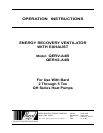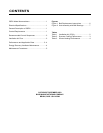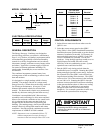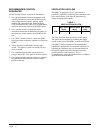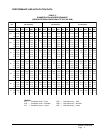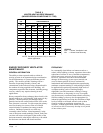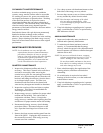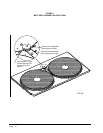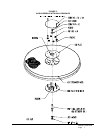
Manual 2100-310D
Page 4
NOTE: Sensible performance only is shown for
winter application.
LEGEND
WVL = Winter Ventilation Load
WH = Winter Heat Recovery
TABLE 3
WINTER HEATING PERFORMANCE
(INDOOR DESIGN CONDITIONS 70° F DB)
tneibmA
.D.OETARNOITALITNEV
BD
FseergeD
.ffE%08MFC054.ffE%18MFC573.ffE208MFC003
LVWRHWLVWRHWLVWRHW
56034244915202046102618231
06068488830504082304236562
55092723855706029406845893
05027967770018165608463135
5405121027952101102800182466
04085414661105121148902790797
5301071806315714118411043118929
03044912555100261221310692172601
52078126947152281267410854155911
02003420449105202204610026148231
51037624831257222240810287121641
ENERGY RECOVERY VENTILATOR
MAINTENANCE
GENERAL INFORMATION
The ability to clean exposed surfaces within air
moving systems is an important design consideration
for the maintenance of system performance and air
quality. The need for periodic cleaning will be a
function of operating schedule, climate, and
contaminants in the indoor air being exhausted and in
the outdoor air being supplied to the building. All
components exposed to the airstream, including energy
recovery wheels, may require cleaning in most
applications.
Rotary counterflow heat exchanges (heat wheels) with
laminar airflow are “self-cleaning” with respect to dry
particles. Smaller particles pass through; larger
particles land on the surface and are blow clear as the
flow direction is reversed. For this reason the primary
need for cleaning is to remove films of oil based
aerosols that have condensed on energy transfer
surfaces. Buildup of material over time may
eventually reduce airflow. Most importantly, in the
case of desiccant coated (enthalpy) wheels, such films
can close off micron sized pores at the surface of the
desiccant material, reducing the efficiency with which
the desiccant can adsorb and desorb moisture.
FREQUENCY
In a reasonably clean indoor environment such as a
school, office building, or home, experience shows that
reductions of airflow or loss of sensible (temperature)
effectiveness may not occur for ten or more years.
However, experience also shows that measurable
changes in latent energy (water vapor) transfer can
occur in shorter periods of time in commercial,
institutional and residential applications experiencing
moderate occupant smoking or with cooking facilities.
In applications experiencing unusually high levels of
occupant smoking, such as smoking lounges,
nightclubs, bars and restaurants, washing of energy
transfer surfaces, as frequently as every six months,
may be necessary to maintain latent transfer efficiency.
Similar washing cycles may also be appropriate for
industrial applications involving the ventilation of high
levels of smoke or oil based aerosols such as those
found in welding or machining operations, for
example. In these applications, latent efficiency losses
of as much as 40% or more may develop over a period
of one to three years.



